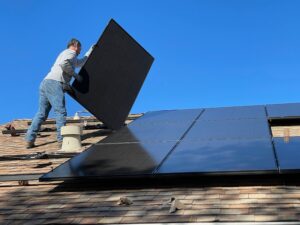Many Idahoans care about clean energy and the environment, but aren’t sure how to start their own personal journey into renewable energy. As part of our Solar Summer celebration, this short guide breaks down what kind of solar programs currently exist and how you can participate in them.
There are two basic ways that you as a customer can get some of your energy from solar or other renewables: rooftop solar and subscription renewable programs.
Rooftop solar
For rooftop solar, customers generally hire a third party solar organization/developer to install solar panels on the rooftop of their home or business. The panels don’t necessarily need to be on a roof (the word “rooftop” is just a convention). You could install a self-standing array in your backyard or in a field by your business, assuming that there are no zoning or neighborhood rules that prevent the installation.
The first step to determining if your home or business is a good candidate for rooftop solar is to check out your utility’s webpage on rooftop solar and then contact your utility for information and assistance (Idaho Power customers click here; Avista customers click here). The next step is to contact a few solar developers. The developer can tell you if your roof gets sufficient sun to support a solar array, and they can help you work through the financials of installing solar. If you choose to install rooftop solar, you will become a net metering customer through the utility. Find out more about how net metering works in our first solar basics blog.

Subscription renewables
Since rooftop solar is a significant financial investment, it may not be an option for everyone. Another option for acquiring some or all of your energy from solar (and other renewables) is through a subscription program. In this program, the utility assigns some of your power to come from green resources. Generally, subscription programs come with an additional monthly fee on your utility bill.
Customers who are interested in subscription programs often wonder if their utility will actually power their home with green power. At a technical level, the answer is no – your power is not necessarily coming from a green source. If you live close to a gas plant, it is likely that most of your actual power comes from gas generation.
However, the utility is still assigning your power to come from green sources. Utilities do this either by building new renewable generation that will fulfill their subscription obligations or, more commonly, by purchasing what are called Renewable Energy Credits (RECs). RECs are created when an entity (another utility or a third-party renewable developer) produces green power. The concepts behind RECs can get complicated, but the most important thing to know is that RECs do not generate what is called additionality, which is the addition of new renewable resources to a utility’s energy portfolio. Instead of actually building a new solar array or wind farm that will serve the utility’s local customers, a utility can “purchase” green power that was produced and consumed in a completely different part of the country. As such, RECs represent green power that likely would have already been produced without the subscriptions. Overall, while subscription programs do support green energy production, they are not the lone solution to our clean energy woes.
Both Idaho Power and Avista have subscription programs. Avista’s program is called My Clean Energy and allows you to pay an additional monthly fee to switch some or all of your power to green power. Idaho Power currently has an identical program (called the Green Power Program). However, Idaho Power recently filed with the state Commission to change this program to its proposed Clean Energy Your Way program. This program, if approved, will give customers two subscription choices. The first will be identical to the Green Power Program. The second will allow customers to subscribe to receive some of their power from a newly built (additional) solar resource. You can find out more information about the Clean Energy Your Way program, including any program updates, on Idaho Power’s website.
Stay tuned for more information about solar throughout our Summer Solar series, or get it right to your email inbox by signing up for our Climate Campaign’s email updates.
